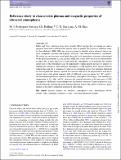Files in this item
Reference study to characterize plasma and magnetic properties of ultracool atmospheres
Item metadata
| dc.contributor.author | Rodriguez-Barrera, Maria Isabel | |
| dc.contributor.author | Helling, Christiane | |
| dc.contributor.author | Stark, Craig Ronald | |
| dc.contributor.author | Rice, Anna | |
| dc.date.accessioned | 2016-01-21T12:10:09Z | |
| dc.date.available | 2016-01-21T12:10:09Z | |
| dc.date.issued | 2015-12-21 | |
| dc.identifier | 240205495 | |
| dc.identifier | 08df06ca-7248-4ef8-a933-78afddf70eda | |
| dc.identifier | 84949294316 | |
| dc.identifier | 000368001600052 | |
| dc.identifier.citation | Rodriguez-Barrera , M I , Helling , C , Stark , C R & Rice , A 2015 , ' Reference study to characterize plasma and magnetic properties of ultracool atmospheres ' , Monthly Notices of the Royal Astronomical Society , vol. 454 , no. 4 , pp. 3977-3995 . https://doi.org/10.1093/mnras/stv2090 | en |
| dc.identifier.issn | 0035-8711 | |
| dc.identifier.uri | https://hdl.handle.net/10023/8054 | |
| dc.description | The authors highlight financial support of the European Community under the FP7 by the ERC starting grant 257431. | en |
| dc.description.abstract | Radio and X-ray emission from brown dwarfs (BDs) suggest that an ionized gas and a magnetic field with a sufficient flux density must be present. We perform a reference study for late M-dwarfs (MD), BDs and giant gas planet to identify which ultracool objects are most susceptible to plasma and magnetic processes. Only thermal ionization is considered. We utilize the DRIFT-PHOENIX model grid where the local atmospheric structure is determined by the global parameters Teff, log (g) and [M/H]. Our results show that it is not unreasonable to expect Hα or radio emission to origin from BD atmospheres as in particular the rarefied upper parts of the atmospheres can be magnetically coupled despite having low degrees of thermal gas ionization. Such ultracool atmospheres could therefore drive auroral emission without the need for a companion's wind or an outgassing moon. The minimum threshold for the magnetic flux density required for electrons and ions to be magnetized is well above typical values of the global magnetic field of a BD and a giant gas planet. Na+, K+ and Ca+ are the dominating electron donors in low-density atmospheres (low log(g), solar metallicity) independent of Teff. Mg+ and Fe+ dominate the thermal ionization in the inner parts of MD atmospheres. Molecules remain unimportant for thermal ionization. Chemical processes (e.g. cloud formation) affecting the most abundant electron donors, Mg and Fe, will have a direct impact on the state of ionization in ultracool atmospheres. | |
| dc.format.extent | 19 | |
| dc.format.extent | 3216310 | |
| dc.language.iso | eng | |
| dc.relation.ispartof | Monthly Notices of the Royal Astronomical Society | en |
| dc.subject | Plasmas | en |
| dc.subject | Planets and satellites: atmospheres | en |
| dc.subject | Stars: atmospheres | en |
| dc.subject | Brown dwarfs | en |
| dc.subject | Radio continuum: planetary systems | en |
| dc.subject | Radio lines: planetary systems | en |
| dc.subject | QC Physics | en |
| dc.subject | NDAS | en |
| dc.subject.lcc | QC | en |
| dc.title | Reference study to characterize plasma and magnetic properties of ultracool atmospheres | en |
| dc.type | Journal article | en |
| dc.contributor.sponsor | European Research Council | en |
| dc.contributor.institution | University of St Andrews. School of Physics and Astronomy | en |
| dc.identifier.doi | 10.1093/mnras/stv2090 | |
| dc.description.status | Peer reviewed | en |
| dc.identifier.url | http://arxiv.org/abs/1509.02769 | en |
| dc.identifier.grantnumber | 257431 257431 | en |
This item appears in the following Collection(s)
Items in the St Andrews Research Repository are protected by copyright, with all rights reserved, unless otherwise indicated.

